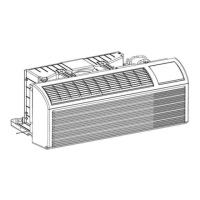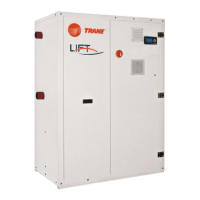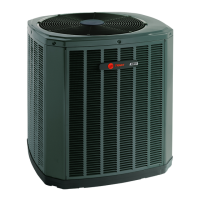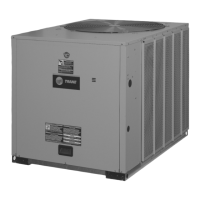36
PTAC-SVX004A-EN
Table 9. Malfunction Causes and Solutions (continued)
Status Cause Solution
Compressor coil burnt out.
Measured resistance between compressor
terminals is 0 or open. Replace the compressor.
Compressor cannot operate. Compressor cylinder may be blocked.
Open compressor to investigate. Replace the
compressor.
Air Conditioning Leaking
There is water leakage indoors. Drainage duct blocked. Eliminate any debris inside drainage duct.
There is water leakage indoors. Unit has incorrect pitch.
Ensure unit is pitched a 1/4" downward from
inside to outside the wall.
Technicians Guidelines
AAppttiittuuddee rreeqquuiirreemmeenntt ffoorr mmaaiinntteennaannccee mmaann
((rreeppaaiirrss sshhoouulldd bbee ddoonnee oonnllyy bbee ssppeecciiaalliissttss))..
1. Any person who is involved with working on or
breaking into a refrigerant circuit should hold a
current valid certificate from an industry-accredited
assessment authority, which authorises their
competence to handle refrigerants safely in
accordance with an industry recognised
assessment specification
2. Servicing shall only be performed as recommended
by the equipment manufacturer. Maintenance and
repair requiring the assistance of other skilled
personnel shall be carried out under the
supervision of the person competent in the use of
flammable refrigerants.
SSaaffeettyy pprreeppaarraattiioonn wwoorrkk
The maximum refrigerant charge amount is shown on
the table below:
NNoottee:: Please refer to the nameplate for the charging
quantity of R32.
Prior to beginning work on systems containing
flammable refrigerants, safety checks are necessary to
ensure that the risk of ignition is minimised. For repair
to the refrigerating system, the following precautions
shall be complied with prior to conducting work on the
system.
• Work procedure
Work shall be undertaken under a controlled
procedure so as to minimise the risk of a
flammable gas or vapour being present while
the work is being performed.
• General work area
All maintenance staff and others working in the
local area shall be instructed on the nature of
work being carried out. Work in confined spaces
shall be avoided. The area around the
workspace shall be sectioned off. Ensure that
the conditions within the area have been made
safe by control of flammable material.
• Checking for presence of refrigerant
The area shall be checked with an appropriate
refrigerant detector prior to and during work, to
ensure the technician is aware of potentially
toxic or flammable atmospheres. Ensure that
the leak detection equipment being used is
suitable for use with all applicable refrigerants,
i.e. non-sparking, adequately sealed or
intrinsically safe.
• Presence of fire extinguisher
If any hot work is to be conducted on the
refrigeration equipment or any associated parts,
appropriate fire extinguishing equipment shall
be available to hand. Have a dry powder or CO2
fire extinguisher adjacent to the charging area.
• No ignition sources
No person carrying out work in relation to a
refrigeration system which involves exposing
any pipe work shall use any sources of ignition
in such a manner that it may lead to the risk of
fire or explosion. All possible ignition sources,
including cigarette smoking, should be kept
sufficiently far away from the site of installation,
repairing, removing and disposal, during which
refrigerant can possibly be released to the
surrounding space. Prior to work taking place,
the area around the equipment is to be
surveyed to make sure that there are no
flammable hazards or ignition risks. "No
Smoking" signs shall be displayed.
• Ventilated area
Ensure that the area is in the open or that it is
adequately ventilated before breaking into the
system or conducting any hot work. A degree of
ventilation shall continue during the period that
the work is carried out. The ventilation should
safely disperse any released refrigerant and
preferably expel it externally into the
atmosphere.
• Checks to the refrigeration equipment
Where electrical components are being
changed, they shall be fit for the purpose and to
the correct specification. At all times the
manufacturer’s maintenance and service
guidelines shall be followed. If in doubt, consult
the manufacturer s ’ technical department for
assistance.
TTrroouubblleesshhoooottiinngg aanndd RReessoouurrcceess

